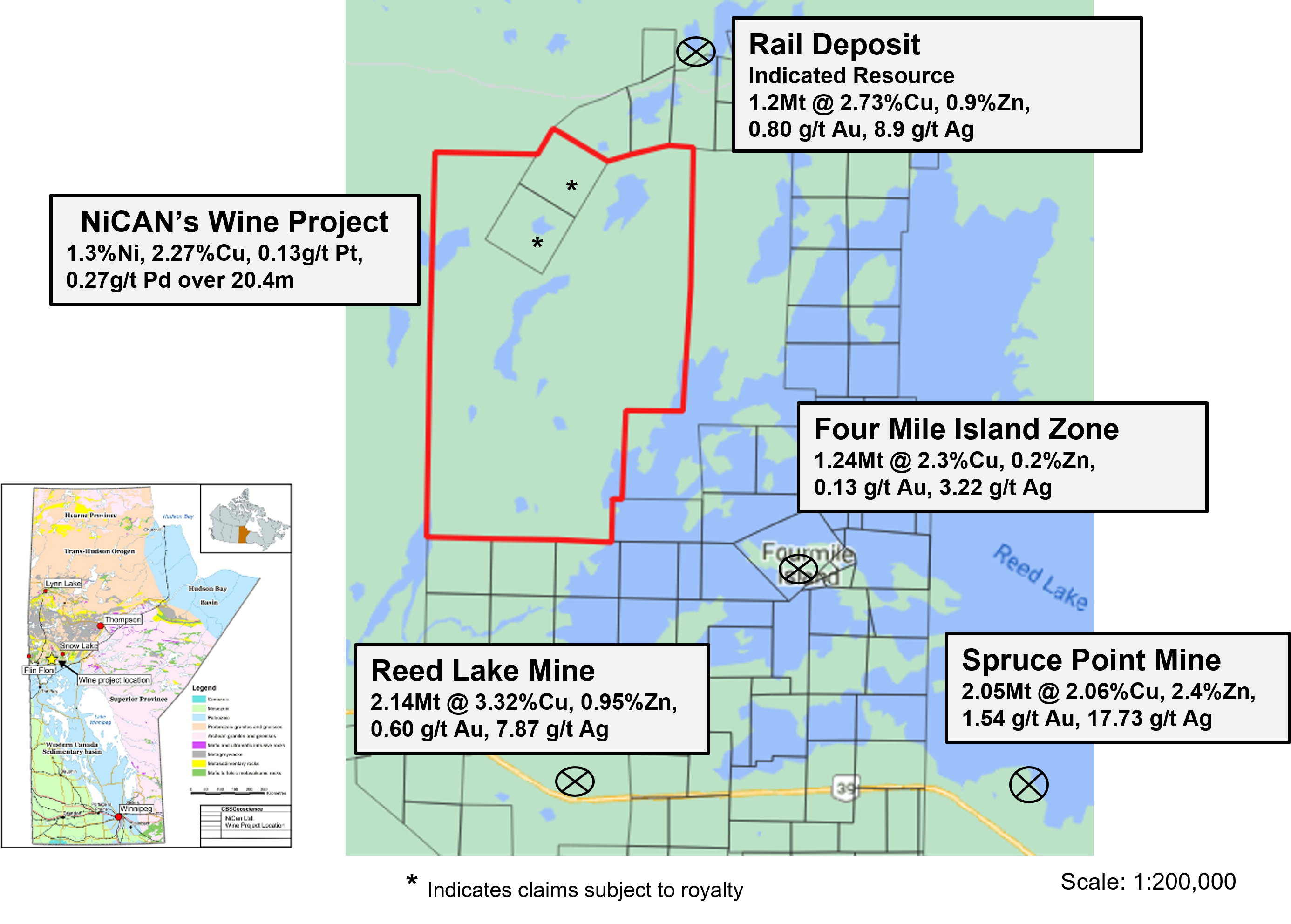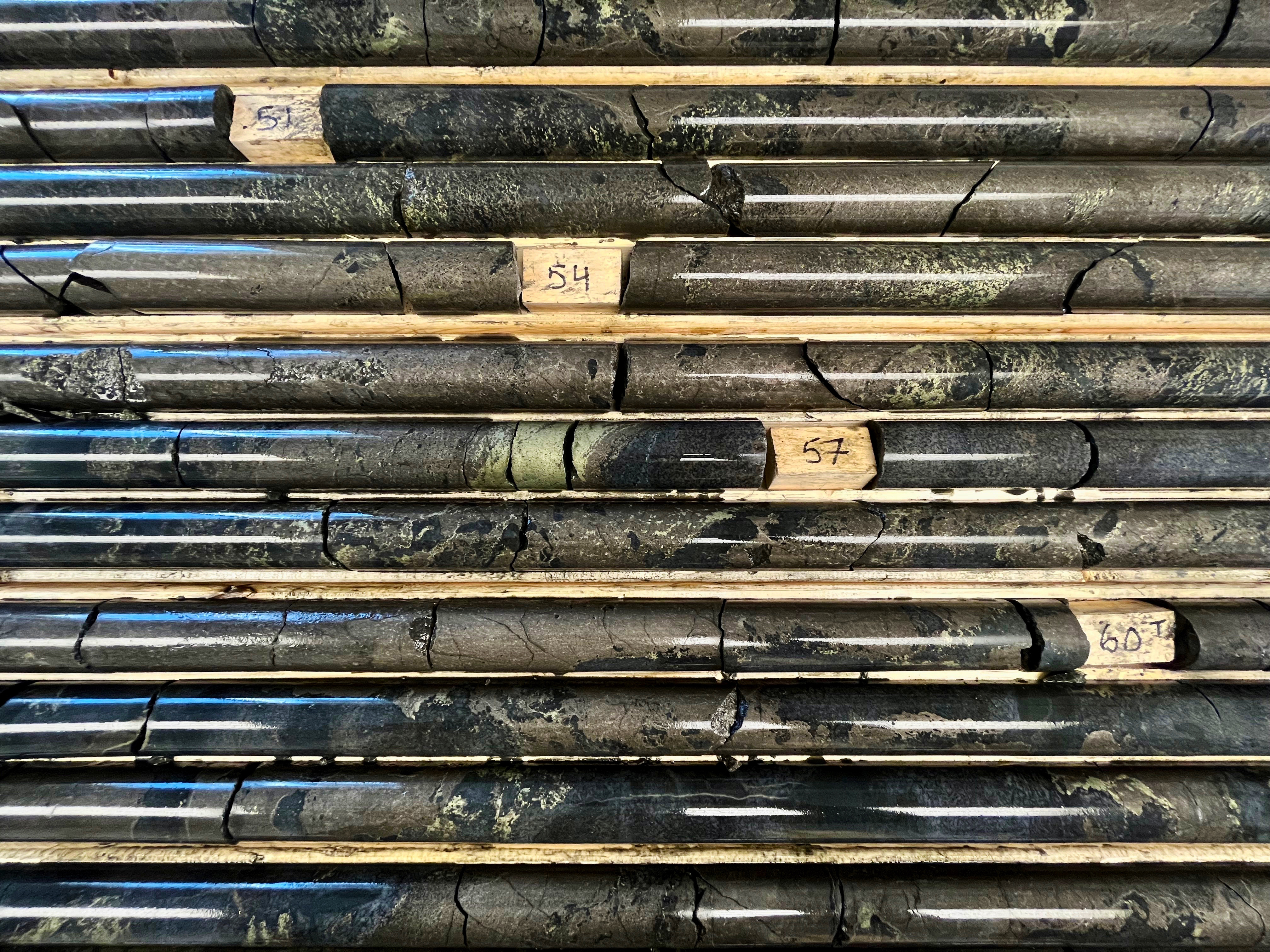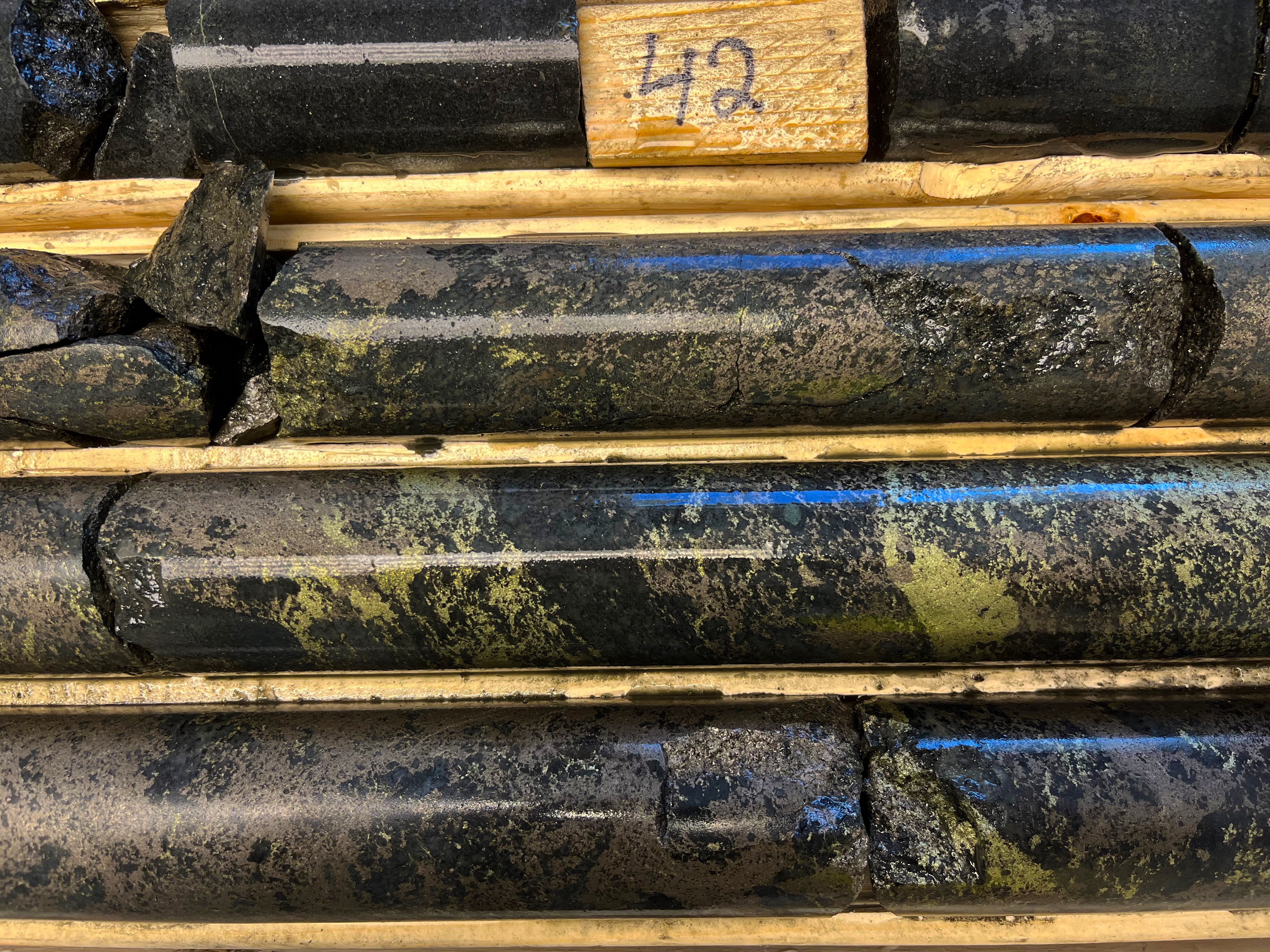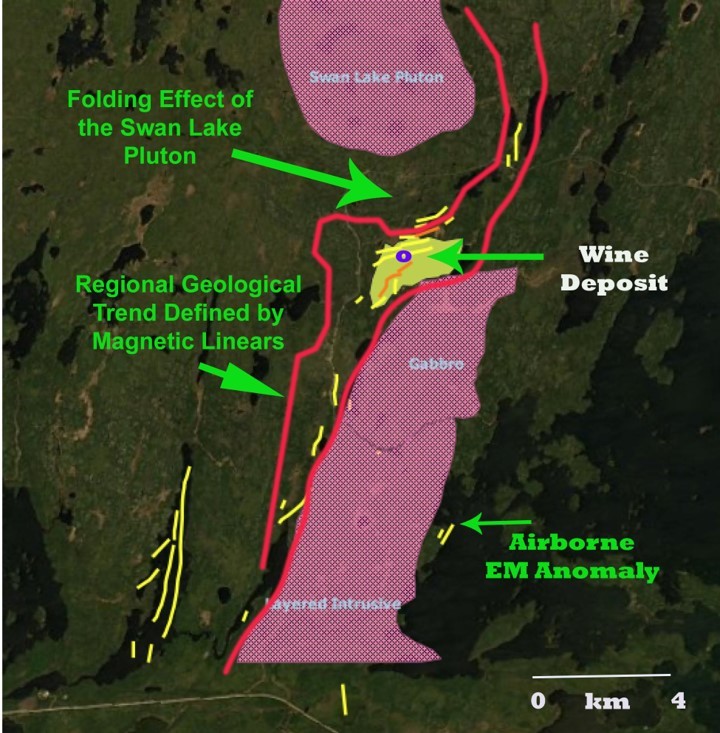
Figure 1 Mines and Deposits in the Wine Property Area
The Wine Project is located within a favourable portion of the highly prospective Flin Flon-Snow Lake Greenstone Belt of Manitoba. The property was acquired based on the Wine Copper-Nickel Occurrence and given the geology of the property is favourable for magmatic nickel deposits, characterized by a geological environment categorized by mafic to ultramafic rocks intruding supracrustal rocks favourable for the development of massive sulphide copper-zinc deposits.
Wine Project Geological Interpretation
Figure 2 Wine Property Preliminary Gelogical Interpretation
Previous exploration on the Wine Property area has largely consisted of drill testing of geophysical anomalies. Initial drilling was very much focused on a massive sulphide copper-zinc deposit model and the recognition of the magmatic copper and nickel potential of the property was not realized until a significant number of drill holes were completed on the property. Because of the early massive sulphide exploration focus, pyrrhotite-rich drill intercepts were not historically assayed for nickel.
The nickel potential of the Wine property was recognized in 1984 with drill hole EEL315 returning 1.20% Ni, 3.08% Cu over 0.2m. Hudson Bay Exploration and Development (HBED) reanalyzed sample rejects from drill hole EEL302 in 1986, which returned significant nickel and copper assays over a considerable intercept (0.78% Ni, 1.03% Cu over 7.92m). Follow up drilling in the Wine Bog area (drill hole EEL346, produced the most significant HBED nickel-copper intercept of 16.5m grading 0.85% Ni and 1.42% Cu. The above-mentioned holes also returned anomalous values in gold, silver, platinum, and palladium.
HBED eventually allowed the EEL claims in the project area to expire in 2002 and the Wine nickel occurrence was staked by W.S. Ferreira Ltd (Ferreira). Cream Minerals optioned the property in 2007 to follow up on the copper-nickel mineralization. Drill hole RAD07-01, with the same collar location as Hudson Bay hole EEL346, intersected 20.4m grading 2.27% Cu, 1.30% Ni, 0.05% Co, 0.319 gm/t Au and 0.402 gm/ PGM. NiCAN subsequently resampled sections of drill hole RAD07-01 supported the historical assay results of 20.36 metres of 1.38% Ni, 2.14% Cu, 0.4g/t Au, and 0.06% Co or 2.09% Ni equivalent. Cream’s option of the property expired, and the property was returned to Ferreira.
Summary of Significant Sulphide Drill Intersections in the Wine Bog Area.
| Drill Hole # | From (m) | To (m) | Interval (m) | Mineralization |
|---|---|---|---|---|
| EEL143 | 79.9 | 94.8 | 14.9 | Semi-massive to massive pyrrhotite, trace chalcopyrite. No nickel assays. |
| EEL279 | 35.4 | 42.2 | 6.9 | Semi-massive to massive pyrrhotite, trace chalcopyrite. No nickel assays. |
| EEL280 | 23.8 | 25.5 | 1.8 | Semi-massive to massive pyrrhotite, trace chalcopyrite. No nickel assays. |
| 40.5 | 48.4 | 7.9 | Semi-massive to massive pyrrhotite, trace chalcopyrite. No nickel assays. | |
| EEL281 | 20.7 | 24.4 | 3.7 | Semi-massive to massive pyrrhotite, trace chalcopyrite. No nickel assays. |
| 26.2 | 27.7 | 1.5 | Semi-massive to massive pyrrhotite, trace chalcopyrite. No nickel assays. | |
| EEL282 | 34.3 | 37.9 | 3.7 | Semi-massive to massive pyrrhotite, trace chalcopyrite. No nickel assays. |
| EEL283 | 36.1 | 39.4 | 3.3 | Semi-massive to massive pyrrhotite, trace chalcopyrite. No nickel assays. |
| EEL288 | 43.0 | 44.7 | 1.7 | Semi-massive to massive pyrrhotite, trace chalcopyrite. No nickel assays. |
| EEL289 | 40.8 | 43.9 | 3.0 | Semi-massive to massive pyrrhotite, trace chalcopyrite. No nickel assays. |
| EEL301 | 33.7 | 41.8 | 8.0 | Semi-massive to massive pyrrhotite, trace chalcopyrite. No nickel assays. |
| EEL302 | 51.5 | 57.9 | 6.4 | 0.93% Ni, 0.88% Cu |
| EEL315 | 68.7 | 68.9 | 0.2 | 1.20% Ni, 3.08% Cu |
| EEL346 | 53.9 | 65.9 | 12.0 | 1.67% Ni, 1.52% Cu |
| RAD07-01 | 55.7 | 76.1 | 20.4 | 1.30% Ni, 2.27% Cu |
Location Map of Historic Drilling on the Wine Property.

Figure 3 Location of Historic Drilling on the Wine Property
The Wine Cu-Ni occurrence shares several characteristics with similar deposits throughout the Trans Hudson Orogen. The Namew Lake Mine south of Flin Flon was operated by Hudson Bay Mining & Smelting starting in 1988 with a pre-production reserve of 2.57 MT grading 1.79% Ni, 0.62% Cu. The deposit was associated with a ca. 1.88 Ga pyroxenite sill intruding into Flin Flon arc assemblage rocks.
Most notably, the geological environment of the Wine occurrence is comparable to the Lynn Lake Ni-Cu deposits mined by Sherritt Gordon Mines Ltd. between 1953 and 1976, producing 22.2 million tonnes grading 1.02% Ni and 0.54% Cu. The Lynn Lake Ni-Cu deposit shares a similar property-scale geological environment hosted within a greenstone belt with a geological history remarkably like the Flin Flon-Snow Lake Belt.
The origin of the Wine Copper-Nickel occurrence is interpreted as a mafic-ultramafic-hosted sulphide deposit, resulting from the intrusion of ultramafic to mafic magma into favourable supracrustal rocks containing a source of sulphur. The presence of gabbroic intrusive rocks in the footwall of the Wine Copper- Nickel occurrence and the abundance of juvenile arc volcanic rocks represents a favourable geological environment for the development of magmatic-hosted sulphide deposits.
The inclusion of sulphide-rich country rocks within ultramafic-mafic-hosts is acknowledged to be a critical feature of sulphide nickel deposits worldwide. The general theory of magmatic-hosted sulphide-nickel mineralization involves the assimilation of sulphide-bearing country rocks, which due to elemental characteristics results in nickel, copper, cobalt and other chalcophile elements preferentially concentrating in the sulphide phase, which due to an inherent immiscibility with the silicate-rich ultramafic magma and greater density, sinks to the bottom of the magma chamber forming the nickel-sulphide deposit.
Geology of the Wine Property
Figure 4 Geology of the Wine Property
The airborne Total Magnetic image of the Wine area indicates that the large Little Swan Lake Pluton located to the north of The Wine Copper-Nickel occurrence has a distinct magnetic signature and its emplacement has caused significant folding to the rocks located to the southeast. It is interpreted that significantly more folding, and deformation occurs than is displayed on the available geology maps. This is especially apparent in the Wine Occurrence area.

Figure 5 Reprocessed Aeromagnetic Data of the Wine Property Area
NiCAN flew a high-definition aeromagnetic survey using a UAV platform over the entire property in 2021. Once processed this survey provided significantly improved definition of underlying rock types and has greatly assisted in re-interpreting the geology and structures of the property. Additional target areas have been defined and are scheduled for ground follow up work later in 2022. Detail analysis of the detailed aeromagnetic data of the Wine Gabbro unit, which hosts the Wine Nickel-Copper Occurrence, along with a study of historic drill logs has allowed NiCAN to be able to distinguish between magnetite rich and pyrrhotite rich horizons.
Wine Project target area
Figure 6 Initial Interpretation of Structures in the Wine Occurrence Area
It is interpreted that the high degree of deformation and high metamorphic grade that characterizes the area has likely resulted in the migration of nickel sulphide mineralization into low strain domains, such as fold hinges and fault zones caused by the intrusion of the Little Swan Lake Pluton thus removing the copper-nickel mineralization from its original host.
Core from Wine Project






